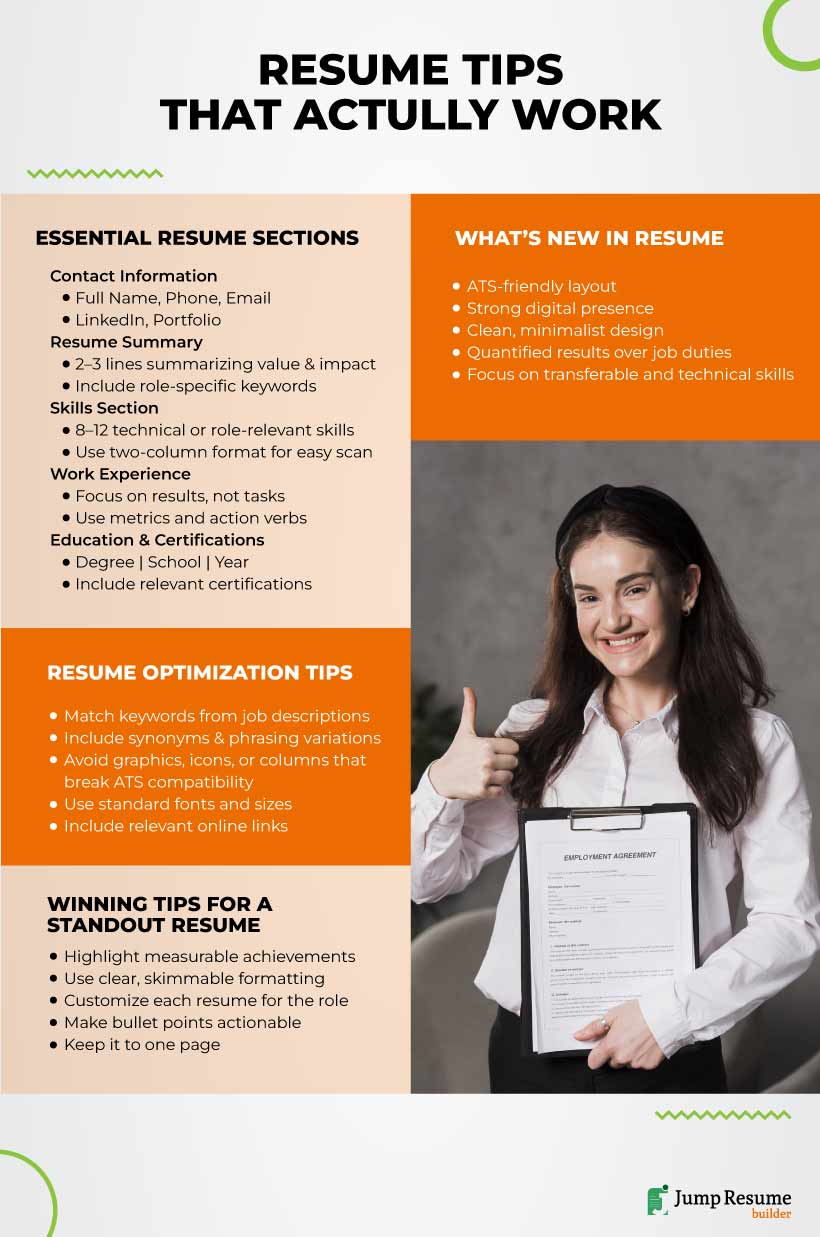Your resume is your golden ticket to job interviews.
However, if you’re sending out those ‘good old resumes’ and expecting them to work, that unfortunately, is not going to happen in 2025. Times have changed, and with the average human attention span at 8.25 seconds, you’ve got a little time to make a lasting impression. So, let’s make the most of that time and craft a resume that makes you stand out in this cutthroat job market.
We have gathered the best resume tips that can help you land your dream job in 2025.
Why a Traditional Resume Won’t Work in 2025?
Remember when you could walk into an office, drop off your resume at the front desk, smile at the receptionist, and maybe even shake hands with someone from HR? Your resume landed on someone’s actual desk. But today? It gets in a digital pile, competing with hundreds of others.
Now, the job market is more competitive than ever. According to a news release by the Bureau of Labor Statistics, the US unemployment rate was 4.1%, with 7.05 million people unemployed. This means that every job opening gets flooded with applications. Additionally, your resume goes through an Applicant Tracking System (ATS) before a human even sees it. It’s scanned, filtered, and scored based on keywords, formatting, and structure. If it doesn’t hit the right marks, it might never make it past the first digital gate.
More companies are adopting remote and hybrid work structures. This shift has broadened the talent pool. So now, you’re not only competing locally; you’re competing with top talent worldwide. Employers have more choices, and you have a shorter window to prove you’re the right one.
On top of that, hiring expectations have evolved. Employers are now looking for evidence of adaptability, digital fluency, and measurable impact. That’s why a generic or outdated resume just won’t work anymore.
Just like you want someone to speak, your resume must speak clearly. Moreover, I should show, not just tell, what you bring to the table.
Now that you know the importance of a modern resume, let’s move on to the tips helping you write an effective resume.
How to Effectively Structure Your Resume?
Think of owning an amazing statement piece but losing it in a cluttered wardrobe. You would just pick another one to wear. The same goes for your resume. A clean, thoughtful structure helps you highlight your accomplishments, and a disorganized resume layout burys down your biggest achievements.
Here are a few tips to keep in mind when designing your resume.
Simple and Scannable Design
Let’s keep it simple. Your resume layout should be clean, clear, and easy to scan. Hiring managers scroll—they won’t read walls of text. Use short, snappy bullet points. Space out your sections with enough breathing room. Avoid cramming everything together. A cluttered resume is a missed opportunity. Keep the font size legible—ideally 11 to 12 pt for body text. Use subheadings to guide the eye. And skip the paragraphs, as recruiters don’t have time for blocks of text.
Quick Tips:
- Avoid underlining or all caps.
- Use bullet points, not paragraphs.
- Maintain plenty of white space.
- Stick to clean fonts like Aptos or Arial.
- Left-align your content for easier reading.
Keep ATS-Friendly Format in Resume
ATS-Friendly Format Applicant Tracking Systems (ATS) are the first gatekeepers. If your resume isn’t ATS-friendly, it may never reach human hands. Stick to standard fonts like Arial, Calibri, or Aptos. Don’t use tables, columns, icons, or graphics — ATS can’t read them well. Use a one-column format with clear section headers. Save your file as a Word doc (.docx) or a plain PDF. Some ATS platforms still struggle with overly designed files or odd file types. Keep it simple and let your content do the heavy lifting.
Quick Tips:
- No tables, graphics, or columns.
- Stick to .docx or standard PDF format.
- Use traditional section headers (Experience, Skills, Education).
- Include keywords used in the job description to make your resume ATS friendly.
Use Color Sparingly
A little color can make your resume pop, but avoid making it look like a party invitation. Using colors subtly, soft neutrals or muted shades like navy, gray, or forest green can help section headers stand out without screaming for attention. Avoid bright red, yellow, or neon shades—they distract more than they help. The goal is to guide the reader’s eye, not overwhelm them.
Quick Tips:
- Use color in moderation.
- Stick to one or two accent colors max.
- Choose professional tones like navy or charcoal.
Keep Your Resume to One Page
Unless you have over 10 years of solid experience, one page is usually your best bet. Recruiters don’t want your entire life story. They want highlights. If you can say it in fewer words, do it. Make every word count. Additionally, prioritize the most recent and relevant roles. However, if your earlier roles add little value, summarize them briefly. Use concise bullet points and not long-winded sentences.
Quick Tips:
- Cut older or less relevant content.
- One page for early/mid-career professionals.
- Two pages only if your experience demands it.
Professional Formatting Tips for Resumes
Content is always the king, but presentation also matters. A polished resume reflects your dedication and shows how organized you are. So, before working on the content, make sure the overall presentation is in your favor.
Professional Summary
Always start strong! Your resume summary is the first thing they see. Make it count. Two to three lines are enough for this part. Make sure to highlight your top skills, years of experience, and key wins.
Quick Tips:
- Avoid vague buzzwords.
- Keep it to 2-3 punchy lines.
- Focus on industry strengths and value.
Professional Email Address
Your email is part of your first impression. It matters more than you think. Always use a clean, formal email address, ideally firstname.lastname@email.com. Skip the old-school nicknames or quirky handles. They come off as unprofessional. Nobody wants to pay attention to someone with the nickname dashingjackson@email.com.
Quick Tips:
- Use a professional domain like Gmail or Outlook.
- Avoid nicknames or slang in your email.
- Double-check for typos.
Don’t Include Outdated Jobs
Listing every job since college isn’t helpful. Focus on the last 10–15 years—especially if you’re experienced. Older roles may feel irrelevant and crowd the space. Keep your content focused and fresh to make your resume relevant.
Quick Tips:
- Highlight recent, relevant roles only.
- Summarize older jobs if needed.
- Focus on roles that match your current goals.
Don’t Include a Photo
In most countries, a photo isn’t required. In fact, sometimes it can hurt more than help. Many companies in the US and UK discourage photos. Plus, ATS systems may misread or reject resumes with images. Remove your photos to keep your resume clean, and distraction-free.
Quick Tips:
- Skip the headshot.
- Focus on content, not appearance.
- Keep the design clean and professional.
Listing Work Experience
This is the most relevant part for hiring managers. It’s where they look first. They’re interested in seeing what you’ve done and what impact you’ve made. Here’s how you can make this section count.
Put it in Reverse Chronological Order
Always start with your most recent role. Move backward from there. That’s the resume format recruiters expect. It makes your latest impact visible right away. Most recruiters just skim through your resume, so your most relevant experience needs to be at the top.
Quick Tips:
- Start with job title, company, and dates.
- Add a short summary line for context.
- Use bullets to showcase impact.

How to Make the Work Section Impactful?
Translate Technical Language into Plain Language
Not all recruiters have technical expertise. Keep your wording accessible. Instead of “Deployed scalable microservice architecture,” try “Built systems to improve product delivery speed.” Highlight the outcome, not just the tool or process. Clarity helps your resume connect, even with hiring managers having no technical expertise.
Focus on Concrete Achievements
Don’t just list responsibilities. Your resume should show what you have achieved. Quantify your impact with numbers to show your measurable impact to recruiters. Did you increase revenue for your last employer? Cut costs in production and management? Improve the efficiency of your team? Add metrics wherever possible to back your claim with data.
Examples:
- Before: Helped reduce response times.
After: Reduced customer support response time by 30%. - Before: Supported staffing efforts.
After: Improved clinical staffing fill rates by 35% through streamlined scheduling and faster candidate onboarding. - Before: Managed sales targets.
After: Increased sales revenue by $200K in one year.
Quick Tips:
- Lead with results, not tasks.
- Add numbers and data.
- Show your value clearly.
Use Action Words
Every bullet point should start with a power verb. Words like “led,” “created,” “managed,” and “optimized” instantly make your resume sound active and confident. They show you take initiative and get things done.
On the flip side, avoid phrases like “responsible for.” They come off as passive and don’t really say what you achieved. Instead of sounding like you were just assigned a task, show how you owned it and made an impact.
Quick Tips:
- Start bullets with strong verbs.
- Keep each point under two lines.
- Focus on how you added value.
Listing Education
Once you’ve laid out your work experience, the next thing recruiters look for is your educational background. It doesn’t need to fill up the whole page, but it should be clear and easy to find.
Let’s see the best way to list this:
Add Experience Before Education (Unless You’re a Student)
Unless you’re fresh out of school, your work experience matters more than your educational background. Place your “Experience” section before “Education.” Employers want to see your hands-on skills first. If you’re a student or a recent graduate, swap the order. Lead with your academic achievements and relevant coursework.
Quick Tips:
- List experience before education (if you’ve been working).
- Prioritize what’s most impressive and relevant.
- Students or graduates can place education first.
- Skip school info if you’ve a degree
Highlight Awards or Achievements
Don’t just drop your degree and move on. Show off a little. If you graduated with honors, earned a scholarship, or got any kind of academic recognition—add it right under your degree. Those small wins can help you stand out from the crowd.
Examples:
- B.A. in Psychology, XYZ University—Graduated Cum Laude
Dean’s List, 2022–2024
Academic Merit Scholarship Recipient
Keep It Clear and Concise
No need to go overboard with details. Just include your degree, major, school name, and graduation year. That’s it. If your GPA is strong (above 3.5), you can list it. Otherwise, you can skip it, as this doesn’t really add value for most employers.
Format Example:
Bachelor of Business Administration
University of Texas, Austin — 2023
GPA: 3.7 | Dean’s List (2021–2023)
Highlighting Skills in Your Resume
This is your resume’s spotlight moment. Here you can show off what you’re great at—not just what you’ve done, but what you bring to the table right now.
Here’s how to make it shine:
Include Both Technical and Workplace Skills
Soft skills are no longer just a nice-to-have; they’re a must. In fact, according to a LinkedIn report, 92% of hiring managers and talent professionals agree that strong soft skills are more important than ever. So, while your technical skills show what you can do, your workplace skills show how you do it. Employers want both.
Can you work well under pressure? Communicate clearly? Lead a team or collaborate across departments? Those traits matter just as much as knowing software or systems.
Now, don’t just list down tons of soft skills. Aim for perfect balance here. Make sure to list your hard skills, like tools, platforms, or certifications. Plus, remember to include soft skills like problem-solving, teamwork, and adaptability. That’s what helps you stand out in today’s job market.
- Add tech tools you know: Excel, Google Analytics, SQL, Salesforce, Canva, or any tool relevant to your discipline.
- Include essential soft skills too: communication, collaboration, adaptability, leadership, and time management.
Resume Content & Strategy Tips (Let’s Get Real About What Works)
This section is the game changer!
Words hold the power to make or break your impression. You must get the content right. Because a sharp layout is great, but if your content doesn’t connect, it won’t matter. Your resume should do more than list your work history. It should really show who you are and tell your story.
Let’s talk about what you can do to make hiring managers stop and stare.
Customize Your Resume for Each Job (Yes, Every Time)
Sending the same resume to every job might feel efficient, but it’s not effective. Hiring managers can spot a generic application right away, and it often sends the wrong message. It tells them that you didn’t really take time for this role.
Instead, speak directly to the job at hand. A little personalization goes a long way. Start by looking closely at the job description and identifying what matters most to the employer.
Here’s how you can tailor your resume without rewriting everything from scratch:
- Use keywords from the job posting throughout your resume.
- Highlight accomplishments that match the goals of that specific role.
- Reorder your resume skills or tools to match what the company emphasizes
Be Honest—but Don’t Downplay Your Contributions
It’s important to be authentic on your resume. You don’t need to inflate your role or exaggerate your success to be impressive. The key is to present your real impact with clarity and confidence.
Even small wins matter. Maybe you didn’t lead a project, but you played a critical support role. Maybe you weren’t the top performer, but you consistently exceeded expectations.
Employers value integrity. They want to see what you’ve actually done. They want to see the real you, not a fantasy version. Just make sure you’re not downplaying yourself either. Own your contributions, and let your work speak for itself.
Add Links to Your Work
Your resume might be catchy and tell a part of your story. But sometimes recruiters require more; they need to see your work. This is especially true for creative and experienced roles.
Adding links to your resume gives employers a way to explore your work beyond what’s on the page. It’s also a great way to show off your digital presence and professional branding.
Here’s what you might include:
- Digital portfolio (especially for design, writing, or marketing roles)
- GitHub profile or code samples (for technical roles)
- Personal website or blog
- LinkedIn profile
Show Your Career Progression Clearly
A strong resume shows how you’ve grown. Employers want to see that you’ve taken on more responsibility over time. That progression tells them you’re reliable, adaptable, and ready for bigger challenges.
Even if you’ve been at one company for years, find ways to highlight growth. Look for moments where you advanced, led new projects, or took on broader roles.
Some good signs of progression to include:
- Added responsibilities or new projects
- Leadership roles, even if informal
- Recognition or internal awards
- Promotions or title changes
Your resume is your personal marketing tool, and you should treat it like one. Make your message so crisp and polished that it easily communicates what you bring to the table. Focus on what matters most. Highlight your achievements. Keep things clean and customized to the job role. Show your value in every line.
Want to build a resume that actually gets you noticed? Jump Resume Builder makes it easy. No guesswork, no overwhelm; just a smart, simple tool to help you create a standout resume from start to finish.
Try Jump Resume Builder today and build a professional resume that helps you land your dream job.
Frequently Asked Questions
What should a resume look like in 2025?
Jump Resume Builder recommends a clean, ATS-friendly format with strong keywords, measurable achievements, and a balance of soft and technical skills.
Is a one-page resume still enough in 2025?
Yes, especially if you have under 8–10 years of experience. A well-structured, single-page resume that highlights key accomplishments and skills often outperforms longer ones that feel cluttered. If you’re unsure what to trim or how to structure it, visit our Blog Section or Help Center for tips and templates.
How do Applicant Tracking Systems (ATS) affect resumes in 2025?
ATS filters resumes based on keywords, formatting, and structure. If your resume isn’t optimized, it may never reach a human recruiter.
Should I include both soft and technical skills on my resume?
Absolutely. Hiring managers look for both. Especially communication, adaptability, and problem-solving alongside your tools or platforms.




